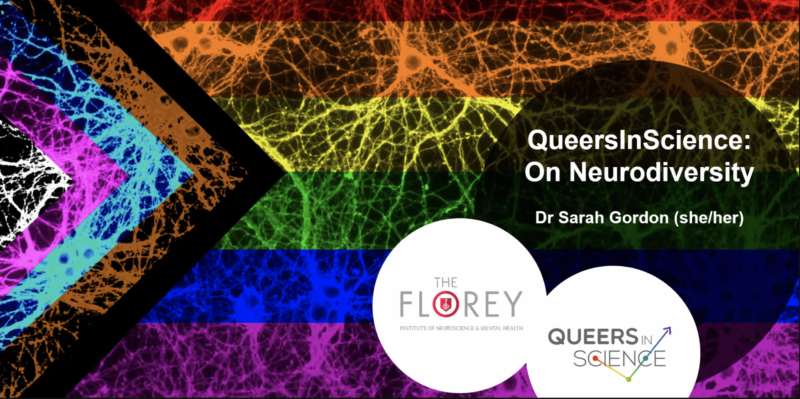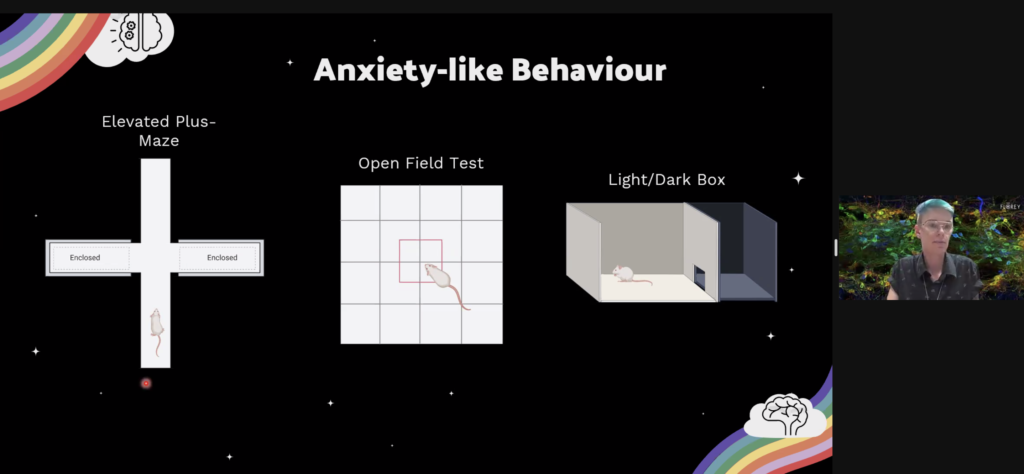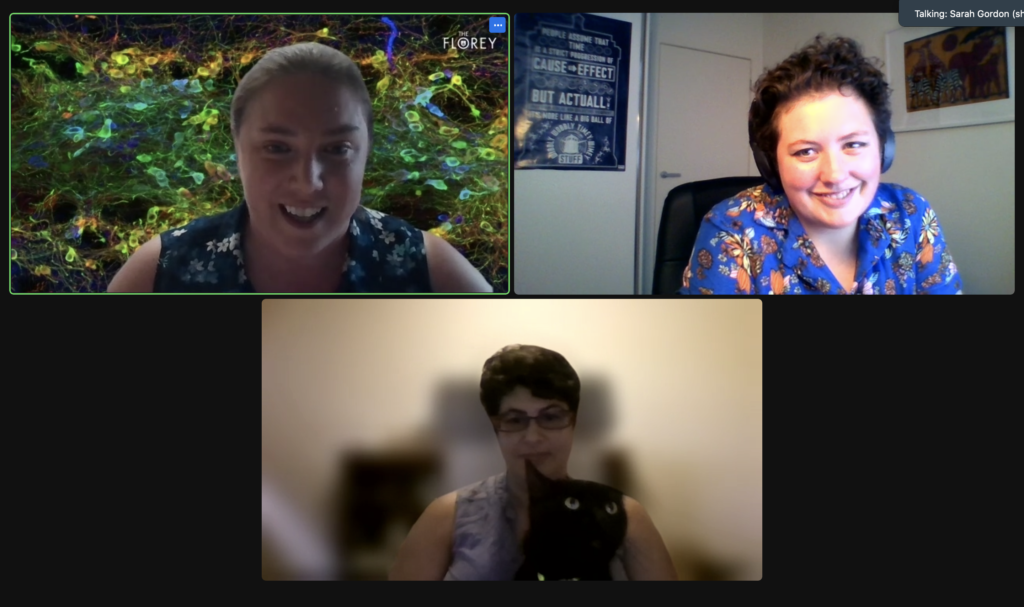The Beautiful Rainbow of Neurodiversity

This article follows a lecture on neurodiversity to Queers in Science, The Florey Institute of Neuroscience and Mental Health, and the Royal Society of Victoria as part of the Midsumma Festival on 27th January 2022. Speakers included Liam Leyden, Kate Huckstep, Dr Emma Burrows and Dr Sarah Gordon, all of the Florey institute of Neuroscience and Mental Health, Dr Daphne Cohen, and Dr Sophia Frenz.
Your brain will not be the same after reading this. Nor will you interpret this article in the same way as anyone else.
Every brain is unique, and we all interact with the world in different ways. Our brains are constantly growing and changing as they adapt to new information and circumstances. This article will become a memory – and (hopefully) new information.
‘I’ve never had a different brain. Of course I think this way – it’s weird to me that others don’t,’ says Dr Sophia Frenz.
The rainbow colours of the pride flag reflect both the immense diversity and the unity of the LBGTQIA+ community. It is therefore quite fitting that the 2022 Queers in Science Lecture discussed something as unique as the brain – something so diverse that no two people’s brains are the same – but those who attended, and you who are reading this article, have come together to learn about it.
The term neurodiversity refers to the essentially infinite variability in our neuro-cognitive abilities and needs. It celebrates differences as beautiful rather deficits. Within this inherent diversity, neurodivergent people interact with and interpret the world in unique ways from what neurotypical people might expect.
By viewing neurodiversity as a normal variation between every single one of us, we can reduce stigma around learning and thinking differences. What if everyone noticed the strengths that come with neurodevelopmental differences such as ADHD, autism, and dyslexia, before the challenges? While the challenges should not be ignore, the strengths can lead to creative problem-solving and new ideas that benefit everyone.
The brain is essentially a bustling hub of communication and differences stem from variations in how the brain is “wired” together. Approximately 86 billion neurons are housed in the brain with each connected to up to 10,000 others. The thousand trillion connections between them all, called synapses, lend themselves to so many possible permutations.
The genetic architecture of each person’s brain is influenced by their genes and life experiences. Throughout life, our behaviours and environment can cause molecular changes that affect how genes work – turning genes up or down, and on or off. These changes subsequently influence proteins, the molecular machines of cells, and how individual neurons in the brain communicate.
Liam Leyden studies the complexities of how one neuron is connected to thousands of others in neural networks. Individual neurons are continuously bombarded with either chemical or electrical signals across the synapses. Liam is interested in how the brain processes sensory information. As we interact with the world, neural networks in the brain need to reflect and respond to the external environment. By measuring the activity of individual neurons and the synapses that link them together, he can form a picture of how they contribute to behaviour and cognition processes.
For insight into the intricate neural mechanisms of behaviour, Kate Huckstep uses animal models. For example, to study anxiety-like behaviour, they assess the exploratory behaviour of mice in different new environments. As foragers prone to predation, rodents have a natural tendency to explore a test arena but tend to avoid open, brightly lit areas. This behaviour can be altered by drugs or genetic mutations that affect innate anxiety. By studying animal behaviour at a molecular level, Kate hopes to develop behavioural and pharmacological support for highly stigmatised conditions.

While Kate has mice running around mazes, Dr Emma Burrows trains mice to play games on touchscreens. She is interested in how genetic mutations linked to autism change a mouse’s memory, attention span and ability to solve problems. She was first introduced to the different realities that children with autism face at the age of 17, working closely with a young, autistic boy. He taught her how differently he saw the world. She witnessed the challenges he faced, but also saw his unique skills. While it could be difficult to draw his attention away from something, he would be highly focused, even throughout repetitive tasks. By linking animal models to the lived experiences of people with autism, Emma hopes that her research will improve diagnosis and awareness, support, and inclusion.
Dr Daphne Cohen and Dr Sophia Frenz face challenges daily as neurodivergent individuals. Growing up, Daphne had always wondered why she was a little different from those around her, and a diagnosis several months ago finally gave her an answer. For Sophia, it was somewhat reassuring to have a word to describe the inner workings of their brain as they come across as outgoing and sociable but realised that they were not quite like everyone else. (There was also a little vindication in their diagnosis as their brother had been assessed as a child but they had not – the wrong child had been checked!)
It is unsurprising that both Daphne and Sophia made it to adulthood without being diagnosed. Many neurodivergent females and non-binary people slip through the cracks. Until recently, it was simply accepted that more males have learning disorders such as autism as part of the ‘male brain’ theory. However, the basis for differences in diagnosis rates is less likely to be biological, but rather, due to biased research and/or diagnostic pathways.
A diagnosis does not guarantee support, but it is an important first step. Sophia is a great advocate for more inclusion and consideration of individual accessibility needs in workplaces. Their access and support needs might change daily but having options available is crucial. They also encourage neurotypical people to be straightforward so that they do not have to question how people are feeling, and importantly, let them have “bad days”.

Both Daphne and Sophia have surrounded themselves with “their people”: a community of people with similar lived experiences. Sophia realised that most of their friends were neurodiverse – they do admit that committing to a PhD does require a certain highly-focused mindset, and students with autism tend to choose STEM majors at university at higher rates than neurotypical students. Many of Daphne’s friends were also diagnosed with ADHD last year and she therefore self-diagnosed herself before receiving a formal diagnosis. She had simply thought that everyone experienced the world as she and her friends did.
While this article can only scratch the surface of Daphne and Sophia’s conversation and experiences, the idea of community seems a fitting point to end. Daphne and Sophia have benefited from being with others who are neurodivergent. Queers in Science was formed to build a community of LGBTQIA+ people in STEM, and it just so happens that it was the first Queers in Science Lecture that brought me to “my people” as a queer scientist myself – I cannot emphasise enough how valuable having a community like this is. Whether it be neurodiversity or diversity in sexuality and gender, our differences are something to share and celebrate.
Catriona Nguyen-Robertson (she/her)
RSV Science Communications Officer
Watch the full lecture and discussion here:
